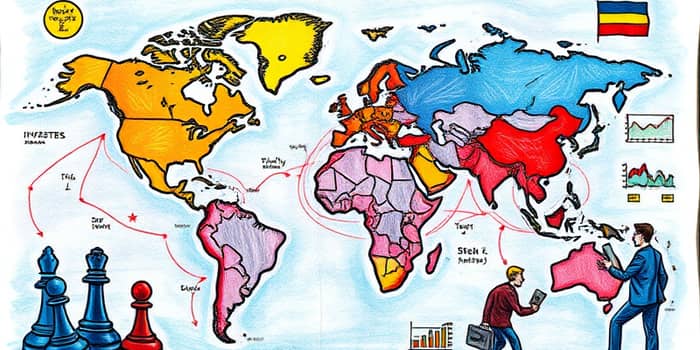In an era of escalating global rivalries and unpredictable policy shifts, investors face a landscape where traditional assumptions no longer hold. Understanding and anticipating these forces is critical for preserving capital and seizing emerging opportunities.
Macro Context: Why Geopolitical Tension Matters
Geopolitical dynamics exert a profound influence on financial markets, supply chains, and corporate strategies. From disrupted trade corridors to sudden asset repricing, states’ actions reverberate through private investments.
Analysts warn that investment stability, profitability, and strategy are all at stake when alliances fray, sanctions multiply, or regulatory regimes tighten. As the world shifts toward a multipolar and fragmented global order, adaptability becomes an investor’s most valuable asset.
Conflict-Driven Risks
Armed confrontations remain a primary catalyst for market turbulence. When wars erupt or intensify, commodities, currencies, and equities can move sharply within hours.
According to recent surveys, state-based armed conflict remains top risk for 2025, demanding close monitoring of hotspots and contingency planning.
- Wars in Ukraine, Gaza, Sudan, and elsewhere
- US-China rivalry across technology and trade
- Proxy wars and civil unrest in fragile states
Structural and Long-Term Risks
Beyond immediate crises, deep-seated trends reshape risk horizons. Long-term investors must recognize how social, technological, and environmental shifts compound geopolitical friction.
- Rising nationalism and political polarization
- Escalating technological and cyber threats to infrastructure
- Compound impact of climate change and extreme weather
- Enduring uncertainties in global governance frameworks
Economy-Driven Risks
Economic instruments of power—sanctions, tariffs, investment screening—are now wielded as strategic levers. This geoeconomic confrontation and sanctions environment forces firms to navigate a maze of trade barriers and compliance hurdles.
Trade conflicts and protectionist measures elevate the cost of cross-border operations, while energy and food price spikes drive persistent inflation. Investors must incorporate policy scenarios into their financial forecasts to avoid unwelcome surprises.
Quantitative Indicators and Macro-Economic Impact
Key macro variables reflect the toll of geopolitical shocks:
• Inflation remains elevated as rising energy and food costs feed through consumer prices in advanced economies.
• Central bank rates are likely to stay above pre-pandemic lows, while sovereign bond yields are elevated across major markets.
• Asia-Pacific continues as the primary growth engine, though it faces its own strategic headwinds.
• The US dollar’s reserve status persists, even as differential rate pressures may soften its near-term strength.
Sectoral and Asset-Class Exposures
Investors are recalibrating portfolios to reflect asymmetric risk–reward profiles. Some sectors benefit from defense spending; others suffer from volatility in commodity prices.
Regional Hotspots
The Asia-Pacific region is under a cloud of strategic competition over Taiwan and South China Sea disputes, with critical mineral supply chains at stake.
Europe’s energy security remains sensitive to Russia-related disruptions, prompting accelerated defense coordination across the EU and NATO.
In the Middle East, renewed proxy clashes and nuclear brinkmanship pose direct risks to oil markets and shipping lanes.
The United States faces policy unpredictability in election years, with shifting trade priorities and regulatory swings affecting market sentiment.
Risk Management Strategies
Leading investors and corporations implement multi-layered defenses to weather geopolitical shocks. Adapting to change is no longer optional but essential.
- Scenario planning and stress-testing portfolios
- Diversification across geographies and sectors
- Onshoring and nearshoring supply chain workflows
- Enhanced compliance and real-time monitoring
- Political risk insurance and financial hedges
- Building operational agility and workforce resilience
Expert and C-Suite Sentiment
Chief executives and asset managers now rank geopolitical and policy risks as top concerns—a stark departure from treating them as mere tail risks. Nearly 25% of global leaders expect state-based conflict to trigger the next systemic crisis.
Think tanks warn of a “G-Zero world,” where weakened global governance mirrors the instability of the early Cold War era, demanding fresh strategic playbooks.
Future Outlook and Wild Cards
Geopolitical volatility is set to persist, presenting both hazards and hidden openings. Investors who can swiftly adapt will find pockets of opportunity in defense technologies, energy transitions, and resilient supply chains.
Potential wild cards include sudden regime changes in volatile states; dramatic technology decoupling or splinternet scenarios; and rapid policy shifts in major powers spurred by domestic crises. Proactive monitoring, agile decision-making, and diversified exposures will separate successful strategies from stranded assets.
As geopolitical tensions reshape the contours of risk and return, disciplined analysis and dynamic resilience will prove decisive. By integrating scenario planning, tactical agility, and robust governance, investors can navigate uncertainty and unlock value in an increasingly complex world.
References
- https://www.shrm.org/enterprise-solutions/insights/top-5-geopolitical-threats-to-businesses-2025
- https://www.spglobal.com/en/research-insights/market-insights/geopolitical-risk
- https://www.wellington.com/en-us/institutional/insights/geopolitics-in-2025
- https://www.eurasiagroup.net/issues/top-risks-2025
- https://www.blackrock.com/corporate/insights/blackrock-investment-institute/interactive-charts/geopolitical-risk-dashboard
- https://kpmg.com/xx/en/our-insights/risk-and-regulation/top-risks-forecast-2025.html
- https://www.matteoiacoviello.com/gpr.htm










